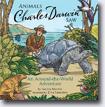 
|
Animals Charles Darwin Saw (An Around-the-World Adventure) is the latest addition to the Explorers Adventure series from Chronicle Books, which has previously featured the travels of Christopher Columbus, Marco Polo, and Robert Scott. The release of this new book on Charles Darwin coincides with the bicentennial of Darwin’s birth and the 150th anniversary of the publication of his seminal work, On the Origin of Species. is the latest addition to the Explorers Adventure series from Chronicle Books, which has previously featured the travels of Christopher Columbus, Marco Polo, and Robert Scott. The release of this new book on Charles Darwin coincides with the bicentennial of Darwin’s birth and the 150th anniversary of the publication of his seminal work, On the Origin of Species.
Author Sandra Markle describes Darwin’s early life and interest in nature and his education at Cambridge in preparation for becoming a clergyman. One of his early and startling experiences as a naturalist involved a beetle that young Charles popped casually into his mouth (he had other beetles in his hands, so he decided to use his mouth to hold the third beetle) when the insect, which may have been a bombadier beetle, released a stinging hot liquid into Darwin’s mouth.
Soon after his graduation, the 22-year-old Darwin received a job offer to travel around the world on the HMS Beagle (although not as its official naturalist). Darwin enthusiastically accepted the offer, and the now-famous journey began on December 27, 1831. The main focus of the book is the voyage of the Beagle and the animals Darwin encountered along his travels. A useful map appended to the book shows the various stopping points along this voyage.
During the four-year, life-altering voyage, Darwin discovered unusually large bones that he guessed belonged to extinct organisms, traveled with gauchos on the pampas, saw llamas for the first time, and was surprised to find flamingos in inland saltwater lakes. In Chile, Darwin discovered huge beds of seashells, far above sea level, leading him to wonder if changes in the earth’s surface could affect organisms living on it.
While studying the Andes volcanoes, Darwin was surprised to find that the two sides of the mountains, one facing the Pacific Ocean and the other facing the Atlantic Ocean, had completely different plants and animals. It appeared that life had adapted to different conditions on the two sides of the Andes.
In 1835, the Beagle reached the Galapagos Islands, a chain of small volcanic islands nearly 1000 kilometers off the coast of South America. Here Darwin noted that although the general types of plants and animals on each of these islands were similar, the organisms varied slightly from island to island. In fact, fisherman confided that they could identify which island a tortoise came from just by looking at it.
Darwin thus recognized that each of the Galapagos islands had its own unique environment - a fact that would eventually create one of the most thrilling scientific breakthroughs of all time.
Markle’s book describes Darwin’s return to England after stops in Tahiti, New Zealand, and Australia, where Darwin was shocked to learn that the letters and specimens he had sent back home during voyages had made him a celebrated scientist. Upon his return home, Darwin was invited to join the prestigious Royal Society of London. He then retreated into relative isolation, studying barnacles and devoting many long years to formulating and working out the details of what would become the theory of evolution, before finally publishing the results decades later in 1959.
This is a very nicely done book. Markle has a knack for explaining the scientific significance of Darwin’s observations during his travels in simple terms that pre-teens can follow, while also introducing them to important technical terms such as transmutation and natural selection. Each two-page spread contains a large illustration, two or three paragraphs of substantive text, and an inset with trivia or notable facts. The map and glossary of terms at the end are helpful.
The illustrations by Zina Saunders are extraordinary, beautiful, realistic depictions of animals, plants and the local geology that make the book both interesting and visually stunning. It is frustrating, however, to find no labels appended to the drawings of various organisms shown in the illustrations. That would have been a valuable addition to teach readers the names of the flora and fauna that Darwin encountered.
Another small quibble is that the author goes out of her way to twice mention that not everyone believes in evolution, a note that seems unnecessary and inappropriate (to this scientist, anyway). Just as one should not expect a Bible to carry a note that not everyone believes in Christianity, it should be equally obvious that a book about science and an important scientist should not require or carry such a qualifier.
The book is geared towards pre-teens but will also prove entertaining to adults who enjoy reading books about evolution or nature. For educating young children about Darwin’s voyage and the animals he encountered, I cannot think of a better or more beautifully illustrated book. Highly recommended!
|







|